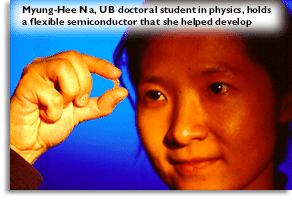
Creative 'error:' Flexible semiconductor is a first
By ELLEN GOLDBAUM
News Services Editor
At first, the physics doctoral students working with a new kind of
semiconductor they developed with two UB faculty members thought they had
made a mistake.
 "They were trying to glue a semiconductor to another piece of
semiconductor, but it didn't glue very well and it just came off," recalled
Hong Luo, assistant professor of physics, who led the group with Athous
Petrou, professor of physics. "They thought it was ruined."
"They were trying to glue a semiconductor to another piece of
semiconductor, but it didn't glue very well and it just came off," recalled
Hong Luo, assistant professor of physics, who led the group with Athous
Petrou, professor of physics. "They thought it was ruined."
Despite that feeling, the next day the students exercised their
scientific curiosity and tested the "ruined" semiconductor for optical
properties, only to find they were still intact.
The UB team had, they discovered, created the world's first flexible
semiconductor.
The first single-crystal, semiconducting nanomaterials that bend, but
don't break were described recently in Applied Physics Letters.
They can be peeled right off their supports almost as though one were
peeling an address label from a sheet of labels and some of them were made
using ordinary weatherstripping silicone.
Semiconductors lie at the heart of micro-electronic devices. "When we
think of semiconductors, we think of a crystal, something that is very hard
and very fragile," said Luo. "But these semiconductors can bend like
rubber."
Because they retain both their structural integrity and optical prop
erties, the semiconductors are seen as particularly significant for future
advances in optical computing, where information will be carried by light
instead of by electrons.
"These semiconductors could help expedite the transition from
electronics to optical computers by allowing us to exploit optics in
semiconductors much more efficiently than has been possible," said Luo.
The new semiconductors are ideal for optical computing because they
will allow for optical waveguides-the optical equivalent of wires-and
semiconductors to be contained inside the same component.
Their flexibility also makes it possible to transmit optical signals in
three-dimensional optical circuits, making their applications far more
efficient and allowing for far more versatile design than now is possible
with two-dimensional transmission of light.
Other applications lie in optical waveguides for telecommunications and
in high-efficiency solar cells for the military, which should be
lightweight but sturdy and flexible enough to withstand rocket blastoff and
battlefield conditions.
"We have developed a general technology to be used with all
semiconductors," Luo explained.
He said the new semiconductors are flexible because they are deposited
on substrates in such thin layers by molecular-beam epitaxy (MBE), a
technique that involves the deposition of thin films on substrates in an
ultra-high-vacuum chamber.
"Theoretically, if you could make it thin enough, even a diamond could
be flexible," he said. "But such thin materials are, of course, extremely
fragile. They need to be supported by something, which makes it a
physicist's problem. We have figured out a way to give mechanical support
to this type of semiconductor structure."
"The flexible semiconductors we developed are man-made structures that
are fabricated using conventional semiconducting elements," he said. "Such
materials possess superior optical properties and can be combined with
polymeric materials because both are flexible."
So far, the UB researchers have fabricated semiconductors that are
about one centimeter in diameter, but Luo said that in facilities used to
make industrial products, samples of up to five inches in diameter and even
larger could be fabricated.
Co-authors on the paper, which appeared in the September issue of
Applied Physics Letters, are Jens J. Haetty, Myung-Hee Na and Huicheng
Chang, all doctoral candidates in physics at UB.
![[Current
Issue]](http://www.buffalo.edu/reporter/icons/Goto_Current.gif)
![[ Table
of Contents ]](http://www.buffalo.edu/reporter/icons/TOC.gif)
![[ Search
Reporter ]](
http://www.buffalo.edu/reporter/icons/Newspaper.gif)
![[Talk to Reporter]](
http://www.buffalo.edu/reporter/icons/Phone.gif)
 "They were trying to glue a semiconductor to another piece of
semiconductor, but it didn't glue very well and it just came off," recalled
Hong Luo, assistant professor of physics, who led the group with Athous
Petrou, professor of physics. "They thought it was ruined."
"They were trying to glue a semiconductor to another piece of
semiconductor, but it didn't glue very well and it just came off," recalled
Hong Luo, assistant professor of physics, who led the group with Athous
Petrou, professor of physics. "They thought it was ruined." 